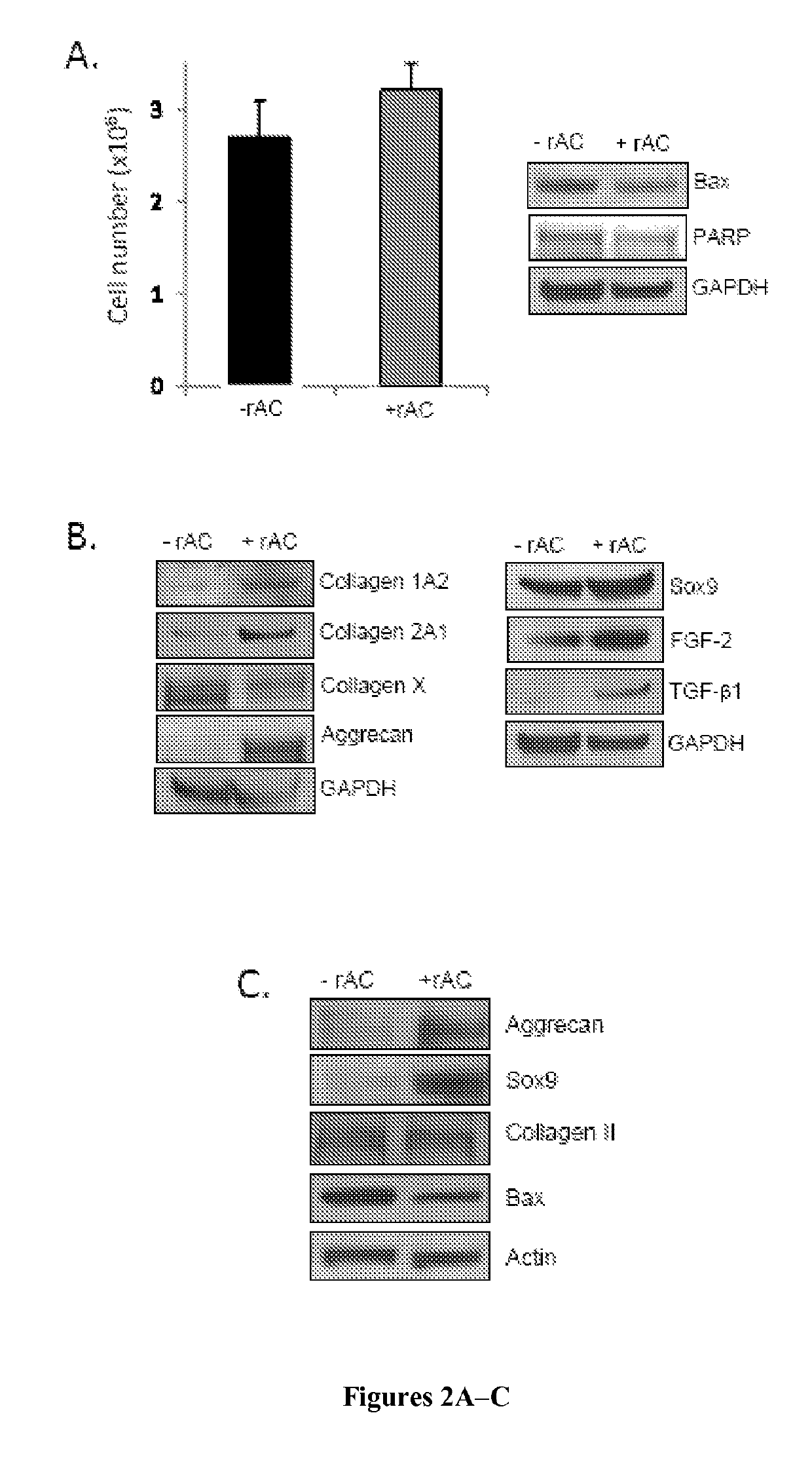Ceramidase and cell differentiation
a technology which is applied in the field of ceramidase and cell differentiation, can solve the problems of increasing the risk of transformation and/or contamination of the stem cell population, the current procedures are not very effective at maintaining the chondrogenic phenotype, and the risk of contamination, so as to improve the chondrogenic phenotype, improve cell quality, and reduce the number of apoptotic cells
- Summary
- Abstract
- Description
- Claims
- Application Information
AI Technical Summary
Benefits of technology
Problems solved by technology
Method used
Image
Examples
example 1
and Methods
[0105]Animals—
[0106]Animals were raised under National Institutes of Health and USDA guidelines for the care and use of animals in research. Normal rats were derived from the MPS VI breeding colony (Kunieda et al., “Mucopolysaccharidosis Type VI in Rats: Isolation of cDNAs Encoding Arylsulfatase B, Chromosomal Localization of the Gene, and Identification of the Mutation,”Genomics 29(3):582-7 (1995), which is hereby incorporated by reference in its entirety) maintained at the Mount Sinai School of Medicine, while the larger animals (cats and horses) were maintained at the University of Pennsylvania School of Veterinary Medicine. The animals were housed with ad libitum food and water. Euthanasia was performed on cats using 80 mg / kg of sodium pentobarbital (Veterinary Laboratories, Lenexa, Kans.) in accordance with the American Veterinary Medical Association guidelines. Euthanasia of rats was performed using carbon dioxide inhalation. Equine cells were obtained during routin...
example 2
n Sphingolipid Metabolism Following rAC Treatment of Primary Articular Chondrocytes
[0136]Primary rat articular chondrocytes were isolated and grown in monolayer cultures as described in Example 1 using DMEM containing 10% FBS with or without rAC. For the baseline timepoint, cells were collected from 6 rats and pooled without culture. The acid ceramidase, ceramide, and sphingsoine levels in these cell lysates were compared to cells grown for 12, 24, and 48 hours with or without rAC. The data is summarized in FIGS. 1A-1C.
[0137]As expected, cells grown in media supplemented with rAC exhibited markedly increased AC activity by 12 hours, and this was sustained through 48 hours. Ceramide levels were also increased compared to baseline by 12 hours, but less in cells exposed to rAC. In fact, by 48 hours the ceramide levels in the rAC-treated cells had returned to baseline, while in those without rAC treatment remained significantly elevated. Also, by 48 hours significant elevations of sphin...
example 3
f rAC Supplementation on Expanded Monolayer Cultures of Primary Articular Chondrocytes
[0139]The effects of rAC supplementation on the phenotype of articular chondrocytes after cell expansion were next evaluated. For these experiments, rat chondrocytes were grown for three weeks with and without rAC in DMEM containing 10% FBS. rAC was added once at the time of the initial cell plating (P0). All analyses were performed at the end of the three-week expansion period unless otherwise mentioned.
[0140]No effect of rAC treatment on the total number of cells was observed (FIG. 2A), consistent with the fact that the levels of two apoptotic markers, Bax and PARP, were also very similar with and without rAC treatment.
[0141]However, despite obtaining the same number of cells, there was a marked effect of rAC treatment on cell quality at the end of the 3-week expansion period, as determined by the expression of various chondrocyte markers. As shown in FIG. 2B, western blot analysis revealed that ...
PUM
| Property | Measurement | Unit |
|---|---|---|
| v/v | aaaaa | aaaaa |
| v/v | aaaaa | aaaaa |
| v/v | aaaaa | aaaaa |
Abstract
Description
Claims
Application Information
 Login to View More
Login to View More - R&D
- Intellectual Property
- Life Sciences
- Materials
- Tech Scout
- Unparalleled Data Quality
- Higher Quality Content
- 60% Fewer Hallucinations
Browse by: Latest US Patents, China's latest patents, Technical Efficacy Thesaurus, Application Domain, Technology Topic, Popular Technical Reports.
© 2025 PatSnap. All rights reserved.Legal|Privacy policy|Modern Slavery Act Transparency Statement|Sitemap|About US| Contact US: help@patsnap.com



